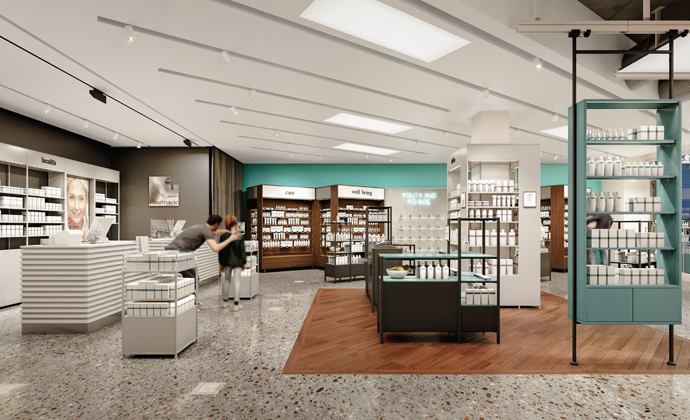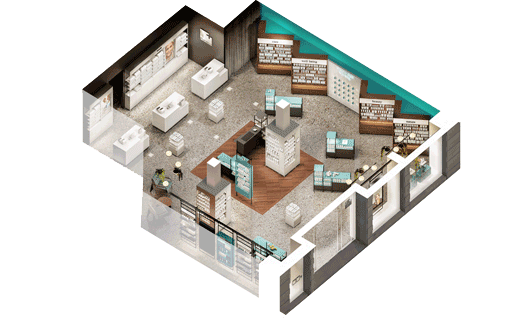
Interior design trends in the pharmacy – being able to do everything but not having to do it today!
You would like to know more?
Contact us
Changeable – flexible – service-oriented
Number of shoppers visiting dispensary in person likely to decrease
In pharmacies, as in many other areas of commerce, a substantial shift of purchases to the online channel1 is expected within the next few years. This development will inevitably impact the frequency of visits to the front office and workflows in the pharmacy’s back office. Tasks are being relocated from the hand-sales table to the back office and are designed for consulting by telephone, video conferencing and merchandise picking. The preparation of “send-outs” and “collections” will increase in volume, increasing the space required in the back office. On the other hand, in the front office, customer visits will decrease, and their demands will also change from a focus on products to a demand for services.2 A significant part of the interaction will thereby shift from the sales desk to the consulting room and the area for non-prescription products. Sales desks can be reduced, and the dispensary can be redesigned and structured.
More focus on products and priority topics in the pharmacy front office
In interior design, retail sales areas nowadays are described as “hybrid space concepts,” which simply means flexible room design and equipment. Flexibility in interior design creates new impulses to make the retail pharmacy attractive and interesting for the pharmacy team and customers. So it’s quite practical to be able to move interior shelving around as quickly as possible – it always creates a new sense of space for the customer. Today’s dispensaries are mainly static – they do not allow for much change. In the future, the front office of the pharmacy should be convertible, enabling space to be made for evening events with seating or for a temporary testing and immunization center. The proper hardware must already be in the room to enable these changes. For the pharmacist, this means “being able to do everything, but not having to do it today.”

In addition to flexibility, focusing on products through proper merchandise illumination is also essential, e.g., with illuminated shelves. Electrified shelving systems provide excellent lighting and should also be quickly interchangeable without tools. This enables a fast reaction to any changes in the product range. Another advantage of having electrified shelves is using electronic price tags without batteries – this is sustainable and means that staff won’t have to spend time replacing batteries.
These requirements are all relevant to the design of today’s pharmacy dispensaries. Modern store fitting systems provide power for LED lights, electronic price tags and IT components such as iPads, POS systems and screens. The focus is always on flexibility in design and positioning. Ceiling power rails, from which lights, shelves and monitor screens can be hung, replace the floor outlet box.
Service desks and fast-lane counters
The role of the pickup terminal or pickup workstation will undoubtedly grow in the front office of the future.² With the increase in electronic (pre-)orders, more and more patients will expect fast service when they take the trouble to make the trip to the local pharmacy. Patients will think, “I’ve already had a consultation, and I’ve paid too, so why should I wait in line just to pick up my drugs?” The “fast lane” of airlines and retail giants has arrived in the dispensary, and the demands of customers along with it. It’s all about rewarding loyalty and providing a pleasant on-site customer experience, whether with a pickup terminal or a VIP service table for Click&Collect.
More mail-order trade in the pharmacy back office
Until now, two workstations have usually been sufficient for prescription processing, appraisal and ordering, but the need for workstations in the back office will increase in the future. Demographic trends in our society and home care will create more work – but the e-prescription will also change pharmacy processes significantly since, for the first time, the original prescription can arrive at the pharmacy before the patient does. This will create the need for more logistics & delivery preparation and more telephone consultation. More “send-outs” and “collections” are likely to become the new reality, but with no direct patient contact in the dispensary – so it makes sense to plan more workstations that are near to the warehouse. Ergonomic and adaptable workstations should also become standard in the pharmacy to make the new way of working as agreeable as possible.
Outlook
The opportunities that e-prescriptions and e-commerce open up for us are exciting, and they can rejuvenate local pharmacies. Pharmacists who correctly interpret the political signals (e.g., the Act to Strengthen Local Pharmacies) and the market (e.g., retail trends in last-mile delivery services and microfulfillment centers) can actively shape the future of local pharmacies and exploit these very promising opportunities for their businesses. Change is the new stability.
The authors
Markus Prange is a visionary and architect savant. He has headed sales in the markets of Germany, Austria and Switzerland for Visplay (VitraGroup) since 2009. He and his team have successfully been implementing projects in the health & beauty sector for several years now. Markus and his team are the sparring partners of architects, retail customers and store & pharmacy builders wherever space needs to be changed or adapted to a changed requirement.
Dirk Bockelmann has been at BD Rowa since 2014. He has been involved in global sales development, product portfolio expansion and trend scouting. Dirk has had a lasting impact on BD Rowa’s success story. He is committed to finding new and innovative trending topics from other retail, healthcare and logistics segments and interpreting them for BD Rowa and the pharmacy market.
You might also be interested in
Blackout in the pharmacy: What to do when nothing works anymore?
First Covid-19, then war in Europe, and now, an energy crisis. For years we have been moving from one crisis to the next, which was previously unthinkable. But, even if the first two are still red-hot and far from forgotten, the next topic is already waiting to be considered: ENERGY.
E-prescriptions and dispensing terminals
New opportunities for local pharmacies. E-prescription is bringing innovations that will simplify everyday pharmacy work.
Pharmacies’ last-mile delivery service – what will the e-prescription change?
Patients have focused more on Pharmacy last mile services during the global COVID-19 pandemic – how should pharmacies position themselves in the future?


